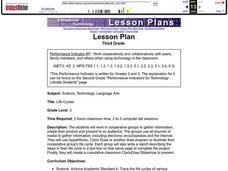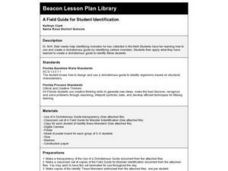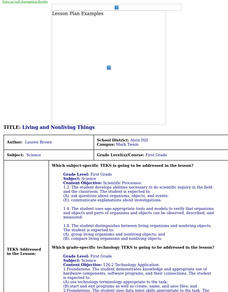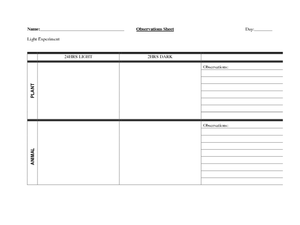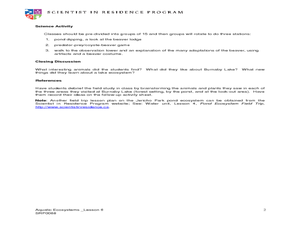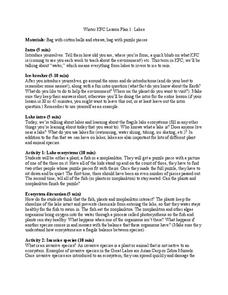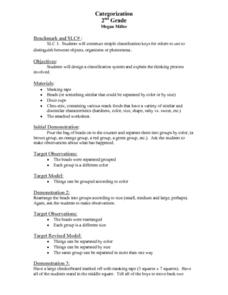Curated OER
Ecosystems: What Are They and How Do They Work?
Students explore the characteristics of major ecosystems, the interactions of the organisms within the systems, and the effects of humans on the system. Both living and non-living components are examined in this five lesson unit.
Curated OER
Plants 'R' Us!
Students investigate the interdependencies of plants and animals, and study what a food web is. They create a food web using yarn and images.
Curated OER
What is an Organism?
Sixth graders take a pre-test and summarize teacher's discussion of cells, tissues, organs in their notebooks. They read selections on organisms in their textbook and perform a dissection of a chicken drumstick with the thigh attached....
Curated OER
Interactions Among Living Things
Students role play predators and prey, classify organisms as predator or prey, and describe factors that affect population growth and size.
Curated OER
LIFE CYCLES
Third graders work in cooperative groups to gather information, create their product and present to an audience. The groups use all sources of media to gather information, including electronic encyclopedias and the Internet. They use...
Curated OER
Building a Dichotomous Key
Pupils analyze how a dichotomous key helps us explain and identify unknown organisms. They design and construct a dichotomous key, developing a list of three observable characteristics per organism.
Curated OER
A Field Guide for Student Identification
Students create and use a dichotomus guide to identify cartoon monsters and use this skill to further their ability to scientifically classify organisms.
Curated OER
Living or Nonliving
Students explore the characteristics that distinguish living things from nonliving things. By examining video and photographs, students gather evidence and develop criteria to decide if something is living or nonliving.
Curated OER
Living and Nonliving Things
First graders distinguish between living and nonliving objects, and compare living organisms and nonliving objects.
Curated OER
The Euglena
For this comprehension worksheet, students read a page about the unicellular organisms called euglena and complete 10 short answer questions.
Curated OER
Organisms – Their Needs
Students compare and contrast different organisms characteristics. In this life science lesson, students design an experiment about plants and animals needs. They collect data and write their conclusion about the experiment.
Curated OER
Burnaby Lake Field Trip
Students identify different organisms found in the lake ecosystem. In this life science lesson, students discover the predator-prey relationship through a game. They explain how beavers adapt to the environment over time.
Curated OER
The Human Organism
Eighth graders investigate animal behavior by studying the lives of three female behavior scientists. For this human organism lesson students do different activities that inquire and approach each females work.
Curated OER
Monarch Egg
Students investigate the stages of the Monarch butterfly and its life cycle. In this butterfly life cycle lesson, students discuss when, where, and how the Monarch butterflies lay their eggs. After discussion, students...
Curated OER
Lakes
Students role-play members of an ecosystem. In this lake ecosystems lesson, students simulate various organisms within an ecosystem to discover the impact on the environment.
Curated OER
How Do Living Things Form Communities?
In this communities worksheet, students will write down 1 main idea about communities formed by living things. Then students will brainstorm 3 details to support their main idea. This worksheet is a graphic organizer.
Curated OER
Classification of Organisms
In this classification activity, students complete a crossword puzzle with 17 clues about vocabulary pertaining to the classification of organisms.
Curated OER
Classification of Organisms Crossword Answers
In this classification worksheet, students are provided with the answers to a crossword puzzle which has 17 clues pertaining to classification of organisms vocabulary.
Curated OER
Science: Putting Down Roots
Fourth graders, in small groups, observe plants and note their characteristics. After drawing pictures of the plants, including their roots systems, they hypothesize in which environments the plants would best thrive. Finally, 4th...
Curated OER
How to Keep Warm in the Arctic!
Students simulate the differences between animals protected by fat and those that aren't. They fill one of the mugs with shortening. Students cut a small hole, and place a thermometer in each piece of cardboard. They position the bulb of...
Curated OER
Is it Alive?
Students watch a demonstration using Duco glue and water and try to determine if the "monster" shown is alive. After the demonstration, they discuss what characteristics make an organism "alive". They participate in a card sorting...
Curated OER
Activity 1: The Effect of Cold on Characteristics Important to Fishes
Learners explore how organisms are adapted to live in the ultimate of extreme environments. They discuss the reasons for the similarities and differences between them, themselves, and the more familiar organisms around them. Students are...
Curated OER
Categorization
Second graders participate in a teacher led bead sorting activity in which they describe different ways the beads can be grouped. Next, they participate in activities in which they sort and resort themselves into groups according to...
Curated OER
"Endangered Species"
Students explore the definition of what an endangered or threatened species is and the criteria for a species being endangered or threatened. Many examples are shown and discussed with the students within this lesson. In addition, they...






